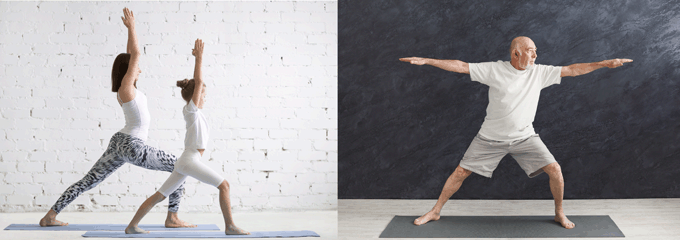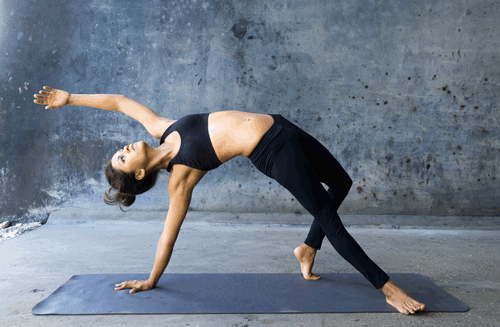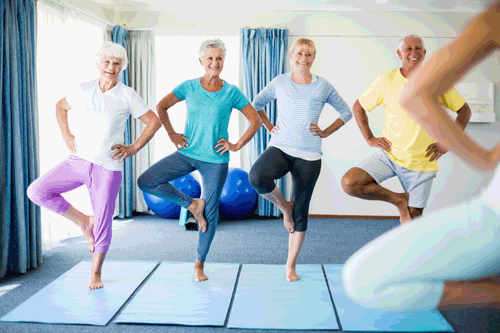By Bernie Clark, June 15th, 2018

Here is an interesting question to ponder: why do we stop growing? There are many researchers with answers to how we stop growing which involve many cellular and chemical processes[1], but we want to know why? A related and compelling question is: why do we age—why does our body decay over time and eventually wear out and die? Again; not “how” but “why?”
There are two main theories that try to explain the answers to these questions[2]: the first we can call the “programmed aging” theory—animals are programmed to wear out and die for many good reasons, like making room for the next generation. The second theory is called the “disposable soma” theory—our bodies (soma) wear out because resources that would otherwise be used to maintain and repair the body are used for other priorities, such as developing the body in the first place and reproduction. The proponents of this view have many reasons why the programmed aging theory is incorrect or at least, not the whole story. (These reasons are beyond our scope of enquiry but a key one is offered in the footnote below. [3]) Personally, I find the disposable soma theory fascinating because it holds lessons for us as students of yoga, and as folks who also just happen to be getting older and older.
The Arc of Aging
In Daoist terms, a newborn is very yang—all flexibility and no stability. [4] Care has to be taken to support its head because it neck muscles are not strong enough to carry it. From that moment on, the baby gets stronger: not more flexible, but stiffer. During this yang-time of life the focus of the child’s energies is to develop an adult body. As the child grows, its ability to take in energy (through the food it consumes) increases in both quantity (it can eat more) and efficiency (it can extract more nutrients from the food it eats.) This is illustrated in figure 1. A child is in the development stage of life and as it grows it gets better at obtaining more energy and uses that energy to grow its body.

However, notice what happens as the child approaches maturity: it now has a sizable body and this new, big body requires energy to maintain it, and repair it when injury occurs or disease strikes. More and more of the energy a growing child obtains is used for maintenance and repair leaving less energy available to continue growing. When the amount of energy needed for maintenance, repair and reproduction equals the amount of energy we get from the food we eat, growth will cease. We have reached a state of equilibrium where the organism no longer needs to grow; it needs to reproduce and rear its young. We could say that yang and yin are in balance at this time: the body has an appropriate amount of both mobility (enough to lead a functional life) and stability (strength). And if we could stay in this lovely, balanced condition, life would be good—there is no need for aging and decay; let’s just stay the way we are at around 25 or 30 years of age.
Sadly, this doesn’t happen. We do decay, slowly (hopefully) over time. The latter stage of the graph shown in figure 1, the stage of protection, illustrates why. As we get older we become slightly less efficient at extracting energy from our food, so our total energy available budget goes down. While this is happening the amount of energy we need to maintain and repair our body increases. These two curves move in opposite directions which create an overdraft in our bank account: and the bank doesn’t like it when we are overdrawn. It takes it out of our hide (and organs, and muscles, and bones, etc.). Eventually, we end life in rigor mortis: we are completely stiff and stable with no flexibility or mobility left. We have become completely yin-like. In the yin-time of life: we become stiffer and less mobile, which is the opposite of the situation we had as children.
Darwinian Fitness
Evolutionary biologists look at the way our body evolved as the answer to why certain things happen. The cellular pathways and chemical reactions that researchers have been uncovering in understanding aging are answers to how these things happen: they are in service to the “why”, not in charge of it. The disposable soma theory is based on how an organism allocates its resources (especially energy) in order to maximize its Darwinian fitness. Any energy allocated to one resource comes at the expense of another resource. [5] There are just a few major resources we can consider in this zero-sum game of energy allocation:
- Growth (development)
- Maintenance and Repair (including our immune system)
- Storage of energy (putting money in the bank for a rainy day)
- Reproduction (begetting and rearing children)
The first stage of life is the stage of development: we are growing our body. The middle stage of life is the maintenance stage: we are keeping what we have. The latter stage of life is the protection stage: we are losing strength, endurance, mobility and overall health, and we have to take care that we don’t become injured.
In our youth, in the yang-time of life, flexibility is already sufficient to meet our needs, for the vast majority of people. Sports and exercise regimes should focus on helping develop the strength and coordination we will need as fully functioning adults. In the middle stage of life, as we slowly become more yin-like, our exercise regimes should focus on maintaining our strength and mobility for as long as we can. This is not the time to focus on gaining more, but on keeping what we have. In the final stage of life, we are in the yin-time. We lose mobility and gain too much stability. We stiffen up and slow down. Since motion is the lotion of life, when we stop moving, we accelerate decay. In the end stage of life, our focus should be on protection: taking greater care to avoid injury due to increasing frailty. Given this view of aging, there are lessons we can apply to our yoga practice based on our current stage of life.
Yoga for the stages

Developmental: When we are young, in the yang-time of life, we lack strength and coordination. A great way to develop both is through play. Games and sports are excellent at challenging the body and developing sophisticated movement patterns. One of the best ways to avoid osteoporosis as an aging adult is to make sure you stress your bones a lot as a child. Strong bones and excellent proprioception will help avoid falls when we are elderly. Standing, running, resistance training, developing eye-hand coordination are all part of our play as children. It is not a workout that children need, just lots of fun activities. Yoga for children and teens should similarly be fun and active. In the yang-time of life, do lots of yang-activities. A youthful yoga practice would include standing postures, hand-stands, balancing postures, and movements with breath.

Maintenance: In our adult years, when we have reached the balance in life between yin and yang, our yoga can likewise have elements of both. We want to maintain three qualities of physical health: strength, endurance and mobility. Resistance training, whether through lifting weights or lots of handstands, pushups, pull-ups, etc. are essential. Down dogs, plank poses, side planks, chair pose, any and all the muscularly challenging postures in yoga are great. But there is no rule saying that yogis can’t also go to a gym or swing kettle bells! Resistance training in yoga often reaches a plateau because the weight of the body is fixed and you may well benefit from other levels of stress beyond your own body weight.
Endurance training can come from strong flowing vinyasa practices, like Power Yoga, Ashtanga, and Kundalini, but it can also come from sports or running sprints. Again, there is no need to insist that all your physical practice has to come from yoga. Instead, you can bring your yoga into these other practices. Yoga is less about what you do, than how you do what you do. [6] You can do your weight training or running with a yogic attitude: one of intention and attention. Finally, mobility can be maintain through both enhancing or maintaining range of motion, which yoga is excellent at—especially the yin yoga style—and through enhancing or maintaining proprioception, which leads to better balance. Examples include lots of balancing postures, perhaps some we loved doing as children: Tree Pose, Eagle Pose, Half Moon, and Side Plank.

Protection: Towards the end of life, now is the time to avoid injuries. We are decaying faster than we would like. That’s life. You are not going to avoid this final stage, unless you die of causes other than old age. (Getting older may be challenging, but you have to admit it beats the alternative!) Through proper attention during the maintenance stage of life you may have pushed away the time when decay really accelerates. But, eventually—it arrives. We are in the yin-time of our life and our focus now is protection. Strength is still needed but it seems we don’t lose strength as fast as we lose mobility and balance. These two functions take on a heightened importance because falls at this stage of life can be fatal. (One common consequence of a fall is a broken hip. Mortality rates for elderly patients who suffered a broken hip is 3 times higher than the population of a similar age: almost 30% of patients with a broken hip die within one year and 80% within 4 years! [7])
Falling can have many causes including a loss of balance. Balance decays as we decay. The average 25 year-old can balance on one leg with eyes closed for about 28 seconds: the average 70 year-old manages only about 4 seconds. [8] There is good news, however—balance can be trained and developed. Standing on one leg, done 3 times a day for a minute at a time with eyes opened significantly helps to reduce the incidence of falling. [9] This practice is called the Flamingo, but we can do very much the same thing in our yoga practice with Tree Pose!
Another ability we lose as we age is mobility. (Mobility can be thought of as a combination of flexibility and coordination. Where flexibility measures how much we can move, mobility measures how well we can move.) A 2012 study at the University of Rio de Janeiro showed a clear correlation between mobility and longevity. [10] In this case mobility was measured by how easily people over 50 years of age could get down and up off the floor, a task known as the “Sit-Rise Test”. Participants who scored in the lowest range suffered 4 times the mortality rates of those in the highest range. [11] A lack of mobility is a major contributor to death, not simply because people cannot move so well, but also because of the impact on a person’s social life. Poor health is not solely due to physical causes! Psychological and sociological factors are also very important. Yoga, especially floor-based practice, if available to the student, is a great way to maintain mobility. Exercises involving simply getting down to the floor and back up again can be very useful. This can be a whole yoga practice in its own: repeated sessions of mindfully sitting down and rising up again will maintain strength, balance and mobility which are the keys to protecting ourselves as we navigate the last stage of life.

One last thought
The disposable soma theory of aging has other lessons we could look at from a yogic perspective, but time is running out. I will leave it to the interested reader to ponder the implications of using energy for reproduction which takes resources away from the function of maintenance and repair. While reproduction and getting our genes passed on to a new generation is the whole point of Darwinian evolution, yogis down through the ages have warned that sexual intercourse comes at a cost. Celibacy is a big part of the ascetic practice, and not just in yoga. We only have a fixed amount of currency in our bank accounts, and if we use energy for one thing, it is not available for another. [12] Reproduction and rearing children have many rewards including giving meaning to life itself, but it also has a cost.
Summary
If a young child suffers an accident and the tip of a finger is severed, it will grow back! When the child is older, it will not. [13] Young children have amazing regenerative powers due to so much energy being available for development. We can generalize and say that this is the time of life for developing strength and coordination: don’t worry about flexibility yet. When we have matured and grown up, we have no energy left to invest in development: we have to maintain the body we built. The older we get, the more we have to work to stay healthy and whole. We take health for granted when we are young, but we fail to realize just how much work staying healthy will take as we age. In the end stage of life, we can generalize and say we have all the stability we need; we need to focus on retaining mobility.
Yoga for children is very different than yoga for adults, which is very different than yoga for the elderly. This is totally understandable. In the yang-time of life, do yang activities: develop strength and coordination. Flexibility and mobility is not yet an issue. In the yin-time of life, do yin activities: preserve mobility, coordination and balance. In the middle of life, seek balance: maintain your strength, mobility and endurance. In all stages of life—move! Remember, motion is the lotion of life.
Footnotes:
- — There are dozens of chemical and genetic events that conspire to make us older. These may include telomere shortening, cellular senescence, decreases in vital hormones such as human growth hormones and insulinlike growth factor 1, too many free radicals, mitochondrial exhaustion, accumulated DNA damages and many other factors. See Jo ão Pinto da Costa et al., “A synopsis on aging—Theories, mechanisms and future prospects” in Ageing Res Rev. 2016 August ; 29: 90–112.
- — By the end of the 1908’s there were over 300 theories about aging, but today many of these have been seen to be subsets of a couple of more generalized theories. See Medvedev, Z.A., “An attempt at a rational classification of theories of ageing” in Biol. Rev. Camb. Philos. Soc. 65, 375–398 (1990).
- — One key argument against aging and death being pre-programmed is the reality that very few animals live long enough to get old. In a raw, natural setting, animals die due to predation, starvation, disease, cold and accidents well before old age sets in. Thus there is no need for Darwinian selection to weed out old, worn out members of the herd or society. Why then would genes evolve to program organisms to decay and eventually die? For other reasons why programmed aging is not a great theory, see “Understanding the Odd Science of Aging” by Thomas Kirkwood in Cell, Vol. 120, 437–447, February 25, 2005.
- — Thanks to Paul Grilley for describing to me the Arc of Aging.
- — See “Understanding the Odd Science of Aging” by Thomas Kirkwood in Cell, Vol. 120, 437–447, February 25, 2005.
- — I first heard this expression many years ago from Bryan Kest.
- — See Jorma Panula et al., “Mortality and cause of death in hip fracture patients aged 65 or older – a population-based study” in BMC Musculoskelet Disord. 2011; 12: 105. Published online 2011 May 20.
- — See “Balance versus age” at https://saveourbones.com/hows-your-balance-take-this-30-second-test-to-find-out/. Unfortunately, they don’t cite the source of these statistics but I have seen them cited in other writings as well.
- — See Sakamoto K et al., “Why not use your own body weight to prevent falls? A randomized, controlled trial of balance therapy to prevent falls and fractures for elderly people who can stand on one leg for ≤15 seconds” in J Orthop Sci. 2013 Jan;18(1):110-20. doi: 10.1007/s00776-012-0328-3.
- — See Leonardo Barbosa Barreto de Brito et al. “Ability to sit and rise from the floor as a predictor of all-cause mortality” in European Journal of Preventive Cardiology, Volume: 21 issue: 7, page(s): 892-898, July 1, 2014.
- — For further details, see my article The Sit-Rise Test.
- — As an aside and to this point, this also applies to our immune system! If you have a cold and decide to still go to work or do a workout, the energy you expend at work is energy that is not available to your immune system. It will take longer to heal when you spread energy over many tasks. Why not commit to healing and stay still! There is a reason that we don’t feel like doing much when we are ill: energy is needed elsewhere. If we didn’t feel sick, we would continue to spend a lot of energy living our normal daily life. Mother Nature knows best: she is telling you to rest. Listen to mother!
- — Cynthia Illingworth, a pediatrician, noticed that a child until about 11 years old who has a fingertip injury down to the first joint will often regenerate the missing bit spontaneously, as long as the injury is left alone. The younger the child, the faster the regeneration. See Illingworth, C.M. “Trapped fingers and amputated finger tips in children’ in J. Pediatr. Surg. 1974, 9, 853–858.
